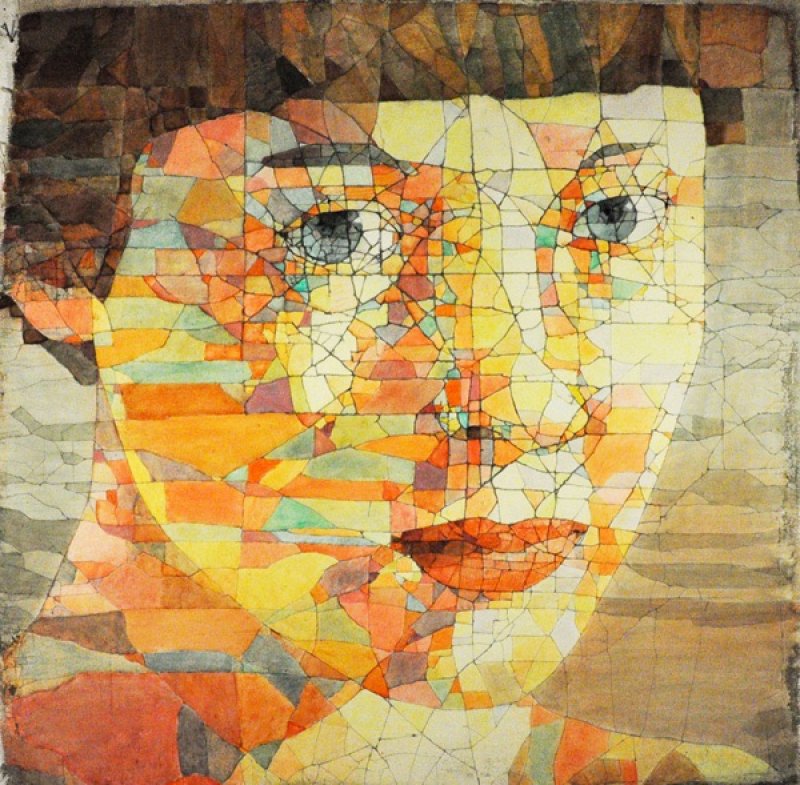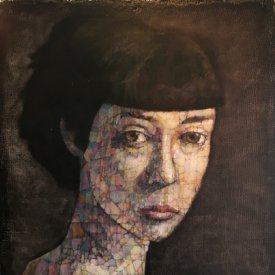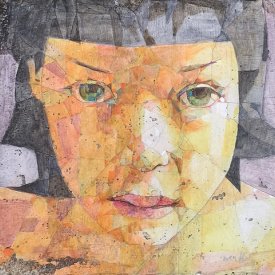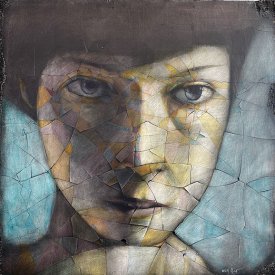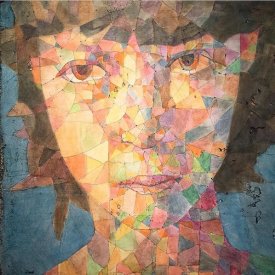Artist Statement
CVI am asked often why I paint faces with so many unrealistic colors. I want to answer this question with another one. How is that someone can see a face when it is painted this way and furthermore see the expression on this “face”? This is what interests me. When I crack the plaster medium I use, I am looking for someone. I have an image in mind when I start, but I let the more or less random lines and cracks and the resultant sections guide me and challenge me to find a person within the constraints of what is given. So the painting never ends up being what I started with. The process leads me to discover someone previously unknown.
When we look at someone, our eyes take cues from points on the face around the features. We also define and remember the outline of the face, the angle at which it is presented, and eventually the hairline, neck and shoulders. We make contact with the eyes- the proverbial windows to the soul. So, as I begin painting, I experiment with these cues, trying a feature one way and then another. I try to stay within the framework of the plaster polygons while I work. Each one is painted with a separate color and one at a time. Little by little I can see the identity of the imaginary person on the “portrait” step forward and introduce him or herself to me. I get a strong sense of someone looking back at me, or perhaps looking intently at something I cannot see.
It is a very curious thing to experience a kind of consciousness emerging in such a way. I think the apparently random colors and lines enhance the experience of working to understand the person we see. I use the same color here and there as I detail the face. The colors sometimes seem to group in an array. One group emerges and then another group comes forth. Certain small areas take the form of an abstract painting all by themselves, then reintegrate into the whole. This creates for me a sense of movement. Just as we can watch someone’s face in real time change slightly as their thoughts progress, we assemble and reassemble the parts of the painting to acquire the entirety of a stranger’s image.
Each painting is an exercise in working through this process. Our mind’s eye is constantly creating and interpreting and this is what I am doing as I paint.
As an artist I have as much trouble explaining my art work as an art critic might have creating art. Any of my explanations come after the fact and are not related to the process of creating. It is easy to relate facts. I can tell you that I began using plaster on burlap because I was trying to imitate the surfaces I saw in photos of paintings by a Spanish artist, Manolo Valdez. He used great masses of oil paint on burlap, letting the raw textile show through and the thick paint crack as it dried. I remember thinking that seemed very expensive to me, and I thought I’d try mixing up some plaster instead. Then, other things began to happen, and now I’m doing the kinds of images presented here that look nothing like Valdez’s paintings.
Looking back, I can articulate now, that then I was fascinated with this two-dimensional art that had a textured body of its own, instead of traditional representational painting-- a framed window looking into another world. At the time, I only knew that I felt an instant and deep connection to the surfaces I saw in the work of Spanish artist Manolo Valdez and others and wanted to make my own. Such work seemed to have an identity and immediacy of presence that connected to the figurative work I had always done, complimenting and enhancing it.
Unlike sculpture, the essence of the physical presence of this new work was not a feature of the image. But at the same time, the art object, as contrasted with the art image, had a presence that could not be dismissed or considered separately. As I sorted through my reactions, I realized that the art object came to represent to me both the presence of the viewer and the subject in the image--the self-consciousness as well as the consciousness of the observer. The experience seemed to me like seeing a face and trying to understand it as friend or stranger, and at the same time seeing the skin on that face independent of expression or attitude. As if seeing one’s own face in a mirror, all the lines and marks, and at once recognizing it as one’s own, while at the same time being surprised by the forgotten details and imagining that face as seen by a total stranger.
I have come to believe that it is through the process of acknowledging texture, recognizing it as evidence of the process of construction, that any object becomes unique, personalized and mysterious, revealing the secret of its individuality and defying categorization.
Although perhaps never used in quite the way that I use it, putting plaster on burlap and other woven materials has a very long history. I discovered this by accident while looking at an exhibit of ancient Egyptian artifacts. I happened upon a painted statue n a glass case, about 20” tall, cracked and deteriorated a bit after three or four thousand years. I immediately recognized it as being constructed of linen covered with a plaster coating. Since then, I have researched this and can tell you that the Egyptians used the technique to preserve the forms of mummies, applying layers of plaster to the wrappings, a process called cartonnage by archeologists.
My process is different. I apply a layer of plaster to burlap and then form it against plate glass to provide a flat, smooth ground for painting. Once dried, the working surface is sealed. Again, after drying, I break the plaster surface, creating a pattern of cracks that I stain. This produces a line drawing that I then paint. Of course, I have begun the process of creating a face or figure at different stages of working with the plaster and burlap because I am always experimenting. Fewer than half of these attempts are successful, since I am looking for both the idea I have in mind and something that develops by chance. I cut, break, crush, scratch and sand the surface. I over-brush the sealer to develop a fine line in the coating. I stain the surface, reseal it, and stain again.
Once I have something I like, a piece that has both image, structural process and individuality, I set about adding color. This too is a process. Sometimes I focus on the abstract patterns in small areas and then later on enhancing the image as a whole. This is an interplay between the surface itself and the image it portrays. At the very end, there are times when I just don’t “like” the “person” I have created, and even if I have succeeded technically, I can’t bear looking at my work. Sometimes I sand it off and try again. Sometimes I throw it away.
